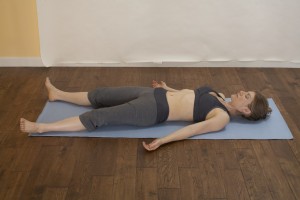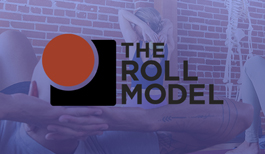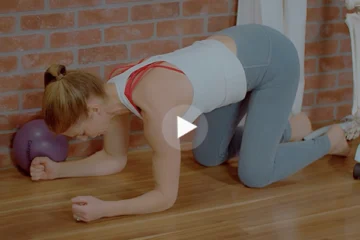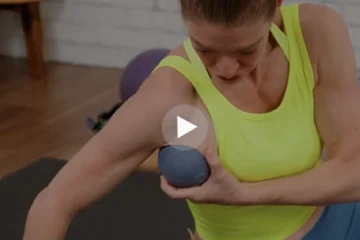
Savasana, or “corpse pose,” can work wonders for those who are challenged with anxiety or have difficulty catching their zzz’s.
This macabre sounding pose is very simple and can be done in any quiet environment. To minimize light and other distractions, place an eye pillow over your eyes.

1. Lay down on the ground, bed or sofa with your legs a couple of feet apart, knees propped over pillows or a yoga bolster, hands about 1 foot away from your sides and palms facing up.
2. Lightly touch your index fingers and thumbs together on both hands to create jnana mudra. Place your attention at the fingertips and begin to feel the heart’s pulsation there.
3. Inhale for a count of three heartbeats and exhale for a count of six heartbeats. (https://www.colburnschool.edu)
4. As you relax more deeply, increase the counts to inhale for four heartbeats and exhale for eight heartbeats.
5. Practice for a minimum of 10 minutes daily at the end of the day to induce deep relaxation and prepare the mind and body for sleeping.
Sweet dreams! For another yoga insomnia remedy, I’ll be posting a video on Monday with a relaxing breath practice.
Read about using Yoga to help you sleep.
Learn about our stress relief products.
Watch our stress relief videos instantly.












I noticed that my walking gait naturally improved by doing the corpse- does this sound silly to you??? I am straight as an arrow now, Luv, Norm
Today is my last day of yoga tune up level one and I have heard so much about breath and bliss 🙂 I look forward to taking it in the future! Coming from a healthcare side and body building (I used to practice yoga a lot, but it’s been 8-9 years since then) I want to find some guidance for my final savasana for my presentation and this is perfect! I love that you layered a breathing practice with corps pose.
The breath ratio is helpful for the parasympathetic nervous system to take over and muscles to begin to release. This article is a great reminder that transitions in daily life are important. Transitioning after work: taking a moment of rest when you arrive home before doing another activity. Or taking a moment of rest in savasana to prepare for sleep, or even using the breathing ratio and mudra in a chair at work before starting on a new project. Bow to the transitions and to rest!
Thanks! I will include pranayama in savasana, student ofen don’t kwow how to relax and calm down.
Up until taking the Level 1 YTU training, I would cue my students to let go of focusing on their breath when they were in Savasana. I now see the richness in using pranayama exercises to take them to a deep place of stillness and peace, as I experienced personally each day of the training. How wonderful to learn something new!
I like the information in this blog. Short and sweet and to the point. Many individuals, these days, are so “on the go” that they keep their sympathetic nervous system on overdrive. I have tried this movement exploration piece with individuals who feel “stress” in their lives. They can actually do savanna in a chair or standing up. What a great meditation piece for this day and age. I will share this with individuals who work in tight office cubicles. Thanks for sharing.
I like the aspect of focusing on counting and breathing with the heart beat to help anxious folks during Savasana. I have never practiced this before YTU but makes complete sense. It gives the people who have a hard time relaxing something to focus on. And, with a longer exhale then inhale, one is able to let go of tension and move stuck energy around. What a great natural way to change sleeping patterns!
I have recently started suffering from insomnia, mostly from stress. In the past, I would go to my familiar side-lying position to find comfort and focus on my breath to reach deeper relaxation. This was the only way I could reach sleep. Recently, with a my renewed yoga practice, I discovered it is now lying on my side that the tension increases. It is a great revelation to witness these changes in my mind and body. I will now also incorporate jnana mudra, thank you.
I love the idea of the 1:2 ratio of inhalation to exhalation for a longer period of time. Not only will this be great advice for anyone with insomnia….I am inspired to give my students longer savasana in class too..the focus on the heartbeat with breath is so calming and quieting to the mind and a great way to draw your awareness inward.
i love the idea of using this pose for insomnia. when i cant sleep, i often panic so much i dont know what to do that wont overstimulate my brain and keep me awake longer. what a great simple reminder that just taking a semi conscious rest pose can contribute to getting REAL rest even if deep sleep is hard to come by.
This makes so much sense–I’ve had students who self-identify as insomniacs snoring on the mat just minutes into savasana. I suspect we often don’t prepare for sleep as mindfully as we do for savasana, and the attention on the breath is such a simple and profound way to cull any busy thoughts.
This is great advice! Such an easy technique to do and teach to others. It’s quite amazing that we can focus our attention to feel our heartbeat in our fingers, temples, and elsewhere. It’s a great way to immediately feel connected to your body and breadth.
I like the idea of feeling my heart’s pulsation in my fingertips as I do the jnana mudra.It’s like I am reminded that there is a higher force moving within me that is not controlled by my mind–that thought relaxes me and then adding the breathing technique of breathing -inhaling and exhaling to a ratio of 1 to 2 totally puts me into a wonderful relaxed state
This SO works. Whenever I have trouble sleeping I’ll begin a savasana practice. In no time I am asleep!
The elongated exhale is so calming for the system. When incorporating it into a class, I am sure to give students a 10 minute savasana. Getting them settled then a minute or two in, ask them to begin to increase the exhale one count at a time until they are 1:2. With about 3 minutes left, they release the breath to feel the difference in their normal breathing. There is a plenty of time for guidance, quiet and meditation. Have only had good feedback and the loooooove the long savasana : )
when I first started doing yoga it was very hard for me to lay in savasana. I just couldn’t stay still, but today I find it to be my favorite posture. I can’t wait to get to the end of the class to enjoy this pose and now I get aggravated when savasana is not long enough. I try to give my students at least a 5 minute savasana during my classes. But I do find when my mind is spiining or the practice that I just completed was too fast I can’t sit in savasana very long. I think I might start incorporating savasana in my daily routine.
Well its nice to visit your site, great helping techniques are shared to cope with insomnia .
thanks for the post.
I also use savasana when I wake up during the night and can’t go back to sleep. This helps me to center myself and turn off the thoughts or discomfort that is keeping me awake. It helps me relax and not stress about not sleeping even if I don’t get back to sleep quickly.
I am looking forward to trying using a 1:2 ratio of inhalation to exhalation as I prepare for sleep or when, like Susan, I awaken during the night. Is it appropriate to provide guided breathing like this during savasana in a group class? Most of my instructors over the years have created a quiet environment during savasana, so I wondered if talking students through a breathing exercise would be distracting for some individuals.
Any suggestions on staying asleep. I can fall asleep using breath easily but awaken often
I often to use svasana to help me relax and fall asleep. I recently found (due to an injury) that the action of propping my knees on pillows or a bolster released my lower back and felt great and allowed me to relax more quickly! This would be easy to try when traveling and in a hotel with lots of pillows around.